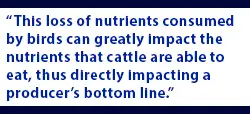
Controlling birds and their mess
 By Jarrod Blackburn
By Jarrod Blackburn
Dairy cows often aren’t the only creatures who enjoy the comfort and safety of barns. Many different species of birds make a dairy farm “home” in the cooler months, posing a risk to the health of livestock and people as well as the farm’s bottom line.
The most common bird to move in is the European starling. Birds, especially starlings, are drawn to farms because of the continuous supply of fresh feed and seek the energy-dense components of the feedstuffs or ration. A starling can eat the equivalent of half its bodyweight in one day. It is not uncommon to see a flock of 10,000 starlings during the winter months. If a flock of that size came through a farm, it could eat more than 900 pounds of feed in a day.  This loss of nutrients consumed by birds can greatly impact the nutrients that cattle are able to eat, thus directly impacting a producer’s bottom line.
This loss of nutrients consumed by birds can greatly impact the nutrients that cattle are able to eat, thus directly impacting a producer’s bottom line.
In addition, birds are associated with the spread and amplification of microbiological hazards, including E. coli, Salmonella, and many others that can have lasting impacts in dairy herds. The most common way these pathogens are spread from bird to livestock is the excretion of feces into cattle feed and water sources.
Lethal solutions
In today’s world, lethal methods to control bird populations are limited. The most common lethal method of controlling starling populations on farm is by using a compound called DRC-1339, which is currently the only toxin for lethal bird control registered by the EPA.
Most nuisance species of birds on farms (sparrows, pigeons and starlings) are not protected under federal law. Thus, trapping and/or shooting are also available methods to help control bird populations. However, these strategies can be time-consuming, and safety needs to be addressed with all farm employees.
Additional strategies
The good news is we have other humane ways to manage bird populations and stop them from visiting or making farms their homes for extended periods.
- Clean up: Cleanliness is of great importance. Clean up waste feed from outside and around bunkers so it’s not as easily accessible to birds. Seal any holes or gaps birds may use to gain access to buildings where food is plentiful.
- Deter perching: Consider using netting in open spaces to block access to the rafters. Sharp wire or barbs on rafters, or chemical agents that make roosting sites sticky or slippery, are common practices used on farm. However, any of these methods can take time and money to maintain over long periods of time.
- Harassment devices: Devices such as propane exploders, hawk kites, ultrasonic sounds, pyrotechnics and others have been used extensively on farm. However, if not used at the right time of the year, their effectiveness drops dramatically, and they are not long-term solutions. Once again, some of these devices require an immense focus on safety.
- Feed components: Recently published research investigated ways to deter starling depredation of feedstuffs using different particle sizes of the energy-dense components. Researchers found they could drastically reduce consumption of feed by starlings using a pellet. While this shows some promise to help, more investigation into the cost-effectiveness of this strategy must be done.
This article was originally written for the October 19, 2020, issue of Progressive Dairy. Click here for the full article.
About the author: Jarrod Blackburn is a Vita Plus dairy specialist in central Wisconsin. He grew up on his family’s dairy farm in Inman, Kansas, and attended Kansas State University for his bachelor’s degree in animal science and industry. After a few years as a location service specialist with a farm cooperative, Blackburn returned to KSU to earn his master’s degree in dairy cattle nutrition. During his graduate studies, Blackburn worked as the KSU Dairy Cattle Judging coach and as a graduate teaching assistant, taking the lead on various dairy nutrition research projects. He joined Vita Plus in 2019.
| Category: |
Animal health Dairy Performance Facility design Feed quality and nutrition |

